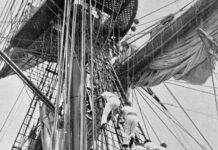 |
| En route to Bermuda, these racers have had to comply with safety regulations that could help any sailor—cruiser or racer—prepare for offshore sailing. |
The requirements for offshore distance races hew to high standards for safety, and we can all benefit from these prescriptions.
Every two years, some 150 offshore sailboats line up in Newport, RI, to race roughly 650 miles to Bermuda, a semi-tropical island in the western Atlantic, almost due east of Charleston, SC. While this is a relatively short ocean passage, it is not always an easy one. Boats have met serious gale conditions and dodged hurricanes during past editions of this race.
Boats racing to Bermuda must comply with the Category One requirements defined in the ISAF (International Sailing Federation) Special Regulations Governing Offshore and Oceanic Equipment and Preparation, popularly known as the Special Regulations. Category One races are defined by US SAILING—the governing body for offshore racing in the U.S.—as “…races of long distance, well offshore, in large unprotected bays, and in waters where large waves, strong currents, or conditions leading to rapid onset of hypothermia are possible, where yachts must be completely self-sufficient for extended periods of time, capable of withstanding heavy storms and prepared to meet serious emergencies without the expectation of outside assistance.”
This definition, with the substitution of the word “cruises” for “races,” is a perfect description of the type of sailing that many sailors dream of—cast off and sail across oceans to distant lands. While the responsibility for compliance with these regulations ultimately lies with the skipper of the boat, the organizers of the Bermuda Race require that each boat undergo a safety inspection to confirm that the boat does in fact meet the regulations. A small, hard-working army of dedicated volunteers—all experienced offshore sailors—conducts these inspections. For years, editors of Practical Sailor have functioned as members of safety inspection teams for sailing events as varied as the One Ton World Champion ships to the Volvo Ocean Race. The Volvo Ocean Race is unique in that it essentially helped foster a whole new category of offshore racing classification—Category 0, or trans-ocean races, including those that pass through areas of extended near-freezing air and sea temperatures, where the risk of death from hypothermia in a man-overboard situation is a constant companion. The Volvo Race is also one of the few races where inspectors are trained, paid professionals rather than experienced volunteers.
For inspectors and skippers alike, the inspection process entails certain anxiety. The skippers hope their preparations pass muster, and the inspectors hope that the boat is so well prepared that the inspection can be conducted without complication. This, unfortunately, is not always the case. Shortcomings are usually the result of failing to keep safety equipment up to date, or failure to understand exactly what the words on the page mean. An unbiased, objective opinion from an experienced inspector, backed up by a carefully written set of requirements that have been developed by an international body over decades of offshore racing, points the skipper in the direction of proper boat preparation for offshore sailing.
Cruisers rarely have the benefit of outside scrutiny of the way their boats are prepared for offshore sailing. Instead, we muddle along, hoping to have done the best we can. The guidelines used by safety inspectors for races such as the Bermuda Race serve equally well for cruisers.
When conducting safety inspections, we request that the skipper lay out all portable equipment beforehand, ready for inspection. This not only gets the gear organized, it gives the skipper the chance to take a closer look at what’s on board. Doing the same thing on a cruising boat gives you the chance to review storage arrangements and examine equipment for damage and proper function.
The ISAF Special Regulations are the bible of the safety inspector. A simplified version of these, Safety Recommendations for Cruising Sailboats, is published by US SAILING. While the Safety Recommendations may be less intimidating at first glance—they’re a mere 35 pages long, rather than the 100-plus pages of the Special Regulations—we’d suggest getting both. The Special Regulations greatly amplify the Safety Recommendations, and reading both will give a clearer picture of just how your boat should be prepared for offshore sailing.
After years of inspecting boats—and being on the receiving end of inspections as well—we have identified a number of recurring issues in complying with safety requirements. Here, we take a brief look at just a few of those areas of concern. Remember, we are zeroing in on just a couple of pages out of 100. There is much, much more that is worthy of discussion. When we quote from the Special Regulations, we have in some cases condensed the wording to save space, but have not changed the meaning.
Companionway Hatches
The companionway hatch not only serves as your primary access below and your main escape route, it is the biggest single hole in the boat that can let water inside in a knockdown or breaking wave.
Regulation 3.08.03: “A companionway hatch extending below the local sheerline shall be capable of being blocked off up to the level of the local sheerline.” To make it easy to get below, many cruising boats have companionway access extending almost to the cockpit sole. A wave breaking over the cockpit—and it’s a matter of when it happens, not if—may go straight belowdecks if the drop boards aren’t in place. In the case of a wave filling a cockpit, a huge amount of water can get below.
Even if it’s not enough water to threaten the boat’s survival, water may damage electrical components, electronics, or engines, as well as wreak havoc on cushions, clothes, and other equipment. On most boats, the nav station is usually near the companionway, and it is likely to be full of things that will suffer.
Regulation 3.08.4: “A companionway hatch shall be fitted with a strong securing arrangement which shall be operable from the exterior and interior.” This is a tricky one. Basically, you have to be able to secure the companionway, but also be able to open it either from the inside or the outside. This means a device that will hold the sliding hatch positively shut, while allowing it to be instantly opened.
One solution to this—and the most elegant one—is a spring-loaded door-type rim latch installed in the top drop board, with the striker plate located in the underside of the sliding companionway hatch. If the latch set includes a lock, you have solved two problems at once. An example of this hardware would be Perko #0930DP or Perko #0927DP, both available from most mail-order marine catalogs or stores. The exact model you need will depend on the actual sliding hatch and drop board arrangement.
“A companionway hatch shall have any blocking devices capable of being retained in position with the hatch open or shut, and whether or not in the position in the hatchway, secured to the yacht to prevent their being lost overboard.” While these requirements are relatively easily met, you rarely see compliance on a cruising boat. The “blocking devices” referred to here are the companionway drop boards or wash boards, depending on how you learned your nautical terminology.
Retaining them in position in the companionway is dead easy: a slide bolt on one side of each board, with the catch mounted on the side rails, will do the trick. The details will vary from installation to installation, but the principle is the same. Anytime the drop board is in place, lock it with the sliding bolt. Likewise, securing the boards to the boat means attaching a lanyard to each board, usually with a small eye strap, and having a similar eye strap mounted somewhere adjacent to the companionway. The reason for both of these is simple. If the boat is knocked down with the sliding hatch in the forward position, the drop board could fall out, leaving you with a gaping hole on deck and no way to plug it. Ideally, the board will have been secured in position with a sliding bolt, but if not, the lanyards should stop you from losing it over the side.
This is not a far-fetched scenario. It actually happened to us just after the start of a race to Bermuda some 25 years ago. The drop boards had been stowed in the cockpit to keep them out of the way, and during a moment of chaos on deck, they went overboard. It happened to be a heavy-air race, and I spent a lot of it sopping up salt water that came below at depressingly regular intervals.
Aboard Calypso, we carried two sets of drop boards: the regular solid teak ones, and a set of screen drop boards the same size. If we lost the primary boards, we could, in an emergency, immediately install the screen boards, encasing them in a heavy plastic trash bag to keep most of the water out. Then, at our leisure, we could cut a piece of plywood to size and secure it over the screens to create a spare set of solid boards. (You do carry spare bits of plywood on board, don’t you?)
Cockpit Locker Lids
Regulation 3.02.1: “A hull, including deck, coach roof, windows, hatches, and all other parts, shall form an integral, essentially watertight unit, and any openings in it shall be capable of being immediately secured to maintain this integrity.” This requires that your cockpit locker lids, along with other hatches and ports, seal tightly. Tensioning hold-down clamp latches should draw the locker lid down onto a thick, compressible gasket without distorting the lid. Multiple latches may be required. You’d be surprised, but an amazing amount of water can get below through a poorly-sealed lid.
Securing Heavy Equipment
Regulation 2.03.2: “Heavy items shall be permanently installed or securely fastened.” It is obvious that anchors, gas bottles, batteries, and engines should be securely fastened to the boat to stay in place in the event of a capsize. Less obvious but equally important are things like the cabin soles, locker lids, and even the top to the refrigerator. These can all cause serious damage or injury if they come adrift in a capsize. The cabin sole is a particular danger, as heavy items are often stowed in the bilge below. These must be secured in place by a mechanism that still allows easy access to the bilge in an emergency. Few racers or cruisers comply with this requirement.
Tools
Regulation 4.16: “An effective means to quickly disconnect or sever the standing rigging shall be provided.” Often, the simplest way to clear a broken rig is to drive out the lower clevis pins. Cutting rigging with a hacksaw is tedious. Large mechanical cutters, or hydraulic cutters, are the best solution. But large cutters are rarely carried by racing boats, as they are heavy. However, on a cruising boat, the additional weight is insignificant. A set of rigging cutters nominally sized to cut up to half-inch rigging is about 30 inches long, weighs about 10 pounds, and costs about $150. In practice, cutters this size are suitable to cut up to 3/8 inch diameter wire, or -17 rod. We would recommend that you purchase rigging cutters at least one size larger than your largest rigging diameter.
Main Boom Preventer
Ironically, one of the most important pieces of safety equipment on any boat—whether sailing offshore or coastwise—is not required for the Bermuda Race, nor is it a requirement within the Special Regulations. It is, instead, only a recommendation. That elusive bit of kit is the main boom preventer.
Given the long history of offshore racing, and the large number of participants, there have been relatively few fatalities in races to Bermuda. The single most dangerous item on any boat is the main boom, and particularly, the risk of someone being hit in the head during an uncontrolled jibe. This risk is at least as great on a cruising boat as it is on a racing boat. Racing boats rarely sail dead downwind, when the risk of a jibe is greatest, since dead downwind is rarely the fastest angle to any destination, even if it is the most direct route. Many of the classic cruising routes, such as crossing the Pacific, require days or weeks of downwind sailing. A preventer holds the boom down and forward to prevent an uncontrolled jibe. It can be as simple as a line tied to a strong padeye on the end of the boom, led down to the rail and secured aft to a cleat. Our own preference is a heavy four-part tackle secured to the boom with a strongly built load-distributing strap, with the lower part of the tackle secured to a heavy padeye or other substantial fitting near the rail.
Stay on the Boat
By far the greatest danger for offshore cruisers is the risk of going overboard. Fully crewed racing boats usually have plenty of hands and eyes on deck to help out in this situation. Most offshore cruising boats are crewed by no more than a couple, and the loss of one crewmember overboard has a high probability of ending in disaster.
The best insurance against going overboard is a good harness attached to a strong point on the boat. Bermuda Race inspectors place a lot of importance on compliance with these requirements. And, like an insurance policy that only goes into force when you pay the premium, the best harness will do you no good whatsoever unless you are wearing it.
The design of safety harnesses and tethers has come a long way in the last 20 years. We now believe that it is important to be able to detach yourself from the boat in some overboard cases—examples would be a boat that is sinking beneath you, or getting tangled underwater in lines or rigging after a rig goes over the side.
The Special Regulations require that harness tethers be equipped with a snaphook at each end. While any number of configurations might meet the letter of the law with regard to this rule, there are only two arrangements that are really acceptable: a six-foot tether of strong, flat webbing with a so-called “safety” hook at each end, such as the Gibb Safety Hook or the Wichard Safety Hook, or a similar tether with a safety hook on one end and a quick-release snap shackle on the other.
Safety snap hooks have a latch mechanism that is extremely difficult to activate accidentally, so that you will not inadvertently detach your self from the boat, as has been known to happen with non-latching snap hooks. At the harness end, however, being able to detach yourself quickly—and with the shackle under load—is an asset. Here, a conventional snap shackle with a short, easy-to-grip lanyard fits the bill. Be aware, however, that this is a double-edged sword. It is possible to accidentally trigger a snapshackle, which can get you in just as much trouble as being too well secured to the boat. Our personal choice is a safety snap hook on one end, with a snapshackle at the chest. You have to weigh the pros and cons yourself in making this decision.
Of course, you need to attach yourself to the boat in a secure fashion, as well. Never clip your safety harness to a lifeline. You must have a dedicated, full-length jackline—either stainless steel wire (uncoated so that any damage to the wire is visible), or properly-made high-strength low-stretch webbing jacklines. A piece of rope run along the deck from one end of the boat to the other is no substitute for a proper jackline, and will be rejected by any safety inspector. You should reject it on your cruising boat as well.
The Special Regs also require strong points—a through-bolted padeye is a good solution—for securing your safety tether. The inspector will expect to see these adjacent to the companionway, near the steering wheel, and any other place where you are likely to spend extended periods of time in one place.
Personal Training
While its enforcement is not the specific responsibility of safety inspectors, the significant level of personal safety training and practice called for by the Special Regulations and the Bermuda Race organizers is a key part of preparation for any crew, whether you’re crossing an ocean or sailing along a coast. Emergencies that require quick response are not limited to offshore sailing. You can fall overboard on a daysail out on a lake as easily as in the Southern Ocean, although the potential for disaster may or may not be the same in the two cases. A person going overboard in a lake who sucks in a lungful of water will drown just as quickly as the bowman on a offshore racer who loses his grip on the foredeck at night in mid-Atlantic.
Appendix D of the Special Regulations describes the crew-overboard recovery procedure known as the Quick-Stop, which is hands down the best solution for shorthanded crews. Remember, if you are sailing your boat as a couple, and one of you goes overboard, you are suddenly sailing singlehanded. Getting your other half back on board requires not only having the right equipment, but knowing how to use it. This is one case where on-the-job training is inadequate.
Practice, practice, practice! Throw a simple cushion, sail for 100 yards, stop the boat, turn around, and get close enough to pick it up. If you have a Lifesling—and you should, particularly when sailing doublehanded—learn how to use it. It does no good for only one of you to know the routine. There’s a high probability that the most experienced half of any couple is the one that will go over the side, as he or she is the one most likely to be on deck doing something stupid.
Section 6 of the Special Regs requires that at least 30% of a racing crew have undertaken an approved personal survival training course in the last five years. For a sailing couple, we’d raise that percentage to 100%. Safety at Sea seminars are given around the country on a regular basis, and you can contact US SAILING to locate an approved seminar near you.
Safety inspectors for races like the Newport-Bermuda Race keep race competitors honest when it comes to safety regulation compliance. For cruisers, you can be your own safety inspector if you will expend the effort to bring your boat—and yourself—into compliance. If you’re in the right place at the right time, take the opportunity to see an experienced safety inspector put a boat to the test. Then go home and take a good, hard look at your own level of preparation.










































